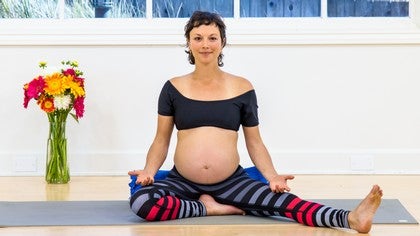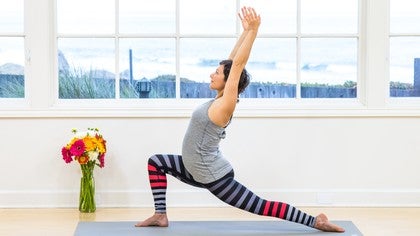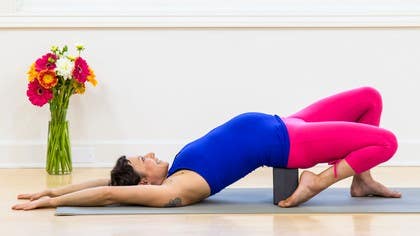Description
About This Video
Transcript
Read Full Transcript
Hi everyone, welcome to this show Move to Meditate. This short tutorial we wanted to talk a little bit about the benefits of moving before dropping into your seated practice and then also a few little tips that can make your seated practice a little bit more easy hopefully. So moving before meditating, I've often found in my experience, and I think many people have found this too, that doing something a little bit more structured, be it breath work that's a bit more structured or movement that sometimes is a little bit more intense than our thoughts, can allow us to really drop in with a clearer space, especially if say you've been sitting all day and you haven't moved a lot, that movement can really clear out the debris, clear out the junk that's just been stagnating in there before you sit down and get really conscious and clear and grounded. So in this series of practices, there's movement practices in which you could choose your intensity level of many of the poses. In my experience, holding things for a little bit longer, kind of using a bit more muscular action, really getting into the body can be useful for feeling grounded and feeling able to sit still because sitting is hard and maybe a lot of you sit a lot in your life, so consciously sitting can be a real challenge and to feel welcome into that seated space, it might be useful to get some movement and to really satisfy that urge for movement and fluidity and opening up the fascia and easing up the spine before getting into a seat.
So some tips on how to sit with a little bit more ease. First off, I want to say that in these practices, we'll work up to about 10-minute meditations, and if that's too much for you, you're always welcome to lie down and focus on the key points in lying down. Sit up against a wall, which might just give your back the support that you need depending on if you have injury or weakness in your spine, or even kicking one leg out, so releasing if your legs fall asleep. You can lie down, take a few breaths, you can kick out your legs, let the blood come back in, and then maybe even come back to a seat. So don't feel like it has to be rigid.
I guess if it's super rigid for you and there's a lot of expectation around what the practice needs to look like, you're probably not going to do it. You're probably not going to enjoy it. So one thing that's super helpful is just make it enjoyable for yourself so that you can get the benefits of the meditation, which are stress reduction and clarity and the ability to focus and the ability to really be there for others, to be present with others and to be available for others because you've been filled up with what you need in order to really serve others. So that's just such a gift that keeps on giving. So let's talk a little bit about the classical meditation posture, which I guess for a lot of us is cross-legged.
And obviously that takes quite a bit of external rotation and ease in the hips. So if you're sitting right on the ground and your legs are way up like this, there's a couple things you can do. I have two blankets for props, but you might also use blocks and bolsters and like pillows and whatever you've got in the house, chair is fine as well. If this just doesn't, it's just not your shape to sit like this, but you can prop your knees up if your outer knees need more support. One of the biggest tips for you is going to be that if the pelvis is really rolling backwards and the shoulders are slumping, there's going to be some pain in the back likely or just a lot of stress on the lumbar spine.
So to find the shock-absorbing quality of your lower spine, you're going to need to elevate your hips so that your knees are, let's say, roughly the distance of your hip crest or your hip crease or maybe even lower, and that's not going to happen for everybody. Say you bring yourself up on one, two, three blankets, whatever you need, and your pelvis is a little bit more elevated, then this tension in your hip flexors and your hips can actually let go. A real good tip for that if you're sitting up tall like that is to flex your feet a tiny bit and support your hips like that. So what you're looking for is that you're not rolling back, is that your lower spine is in its natural curve, which is a little bit of a concavity. Sometimes what really helps is to pull your buttock muscles back so that if you can feel your sit bones, the two bones that you sit on, that you're not rolling onto the back edges of them, that you're actually rolling onto the front edges of them so that your lower spine is, I mean, it doesn't have to be coming in, but at least it's not rolling back entirely.
The top rim of the pelvis, the top of your pants, isn't collapsing backwards. So at least the ability to sit up, which will in turn allow you to relax and open and neutralize the shoulders. Otherwise you're going to be in this position, which is just so compressive, the abdomen's going to feel tight, the breath is going to feel restricted, and the head and neck are also going to hop into that play and the back of the neck is going to get really tired. So what we want to find is a little bit of that moving in of the lower back, shoulders soft, and the skull alignment, hopefully not a forward head, so we really want to bring the skull and the weight of your skull, which is quite heavy, on top of the spinal line. So you can try to think about the top of your mouth, the roof of your mouth lining up somewhat over the floor of your pelvis, the pelvic floor.
So that you're somewhat aligned, it's like your vertical line, the strength of your spine, is allowing you to relax your shoulders and allowing you to relax your neck so you're not in this position. So main point there. And if you're starting to feel pain, if you're starting to have your legs fall asleep, then the most important things that you feel comfortable, spacious, somewhat relaxed, I mean alert
Move to Meditate: Lydia Zamorano
Comments
You need to be a subscriber to post a comment.
Please Log In or Create an Account to start your free trial.









